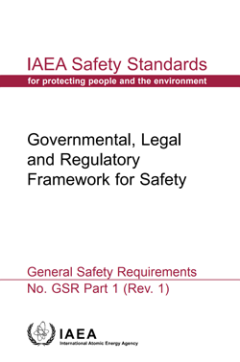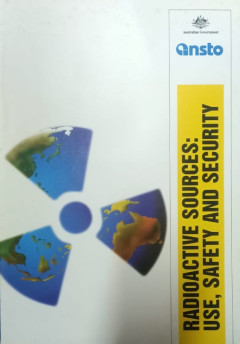Ditapis dengan

IAEA Safety Standards Series Management of Waste from the Use of Radioactive …
Dokumen ini membuka wawasan mengenai arsitektur regulasi ketat yang ditetapkan oleh IAEA Safety Standards Series, yang merupakan tulang punggung perlindungan global terhadap radiasi pengion. Seri ini menetapkan hierarki panduan yang jelas: mulai dari prinsip fundamental dalam Safety Fundamentals (biru), diikuti oleh pernyataan keharusan yang mengikat (pernyataan "shall") dalam Safety Requiremen…
- Edisi
- -
- ISBN/ISSN
- -
- Deskripsi Fisik
- 68p.: illus. ; 29 cm.
- Judul Seri
- -
- No. Panggil
- 621.483 IAE S

Safety Guides Safety Series Classification of Radioactive Waste
Dokumen ini adalah panduan fundamental yang diterbitkan oleh Badan Tenaga Atom Internasional (IAEA) pada tahun 1994, dan merupakan produk kunci dari RADWASS Programme (Radioactive Waste Safety Standards), inisiatif yang didedikasikan untuk menetapkan standar global untuk keselamatan limbah. Sebagai bagian dari Safety Guides (Seri Keselamatan No. 111-G-1.1), karya ini menempati posisi penting da…
- Edisi
- -
- ISBN/ISSN
- 92-0-101194-6
- Deskripsi Fisik
- 40p. : illus. ; 24cm.
- Judul Seri
- -
- No. Panggil
- 621.483 IAE S

IAEA -TECDOC-1355 Security of radioactive sources interim guidance for comment
Dokumen IAEA-TECDOC-1355, yang diterbitkan oleh Badan Tenaga Atom Internasional (IAEA) pada Juni 2003, menyajikan panduan sementara yang krusial tentang Keamanan Sumber Radioaktif (Security of radioactive sources). Karya ini muncul sebagai respons mendesak terhadap pengakuan bahwa publikasi IAEA sebelumnya hanya memiliki persyaratan keamanan yang umum, yang utamanya ditujukan untuk menangani pa…
- Edisi
- -
- ISBN/ISSN
- -
- Deskripsi Fisik
- 13p.: illus. ; 30 cm.
- Judul Seri
- -
- No. Panggil
- 621.483 IAE S

Categorization of radioactive sources Revision of IAEA-TECDOC-1191, Categoriz…
Buku Categorization of Radioactive Sources (IAEA-TECDOC-1344, Juli 2003) merupakan publikasi penting dari International Atomic Energy Agency (IAEA) yang merevisi TECDOC-1191. Dokumen ini menyajikan pedoman internasional mengenai klasifikasi sumber radioaktif berdasarkan tingkat risiko dan potensi dampaknya terhadap keselamatan, keamanan, serta kesehatan manusia dan lingkungan. Selain mengura…
- Edisi
- -
- ISBN/ISSN
- -
- Deskripsi Fisik
- 34 p. : illus. ; 30cm.
- Judul Seri
- -
- No. Panggil
- 539.723 IAE C

Categorization of Radioactive Sources | IAEA Safety Standards Series No. RS-G…
Badan Tenaga Atom Internasional (IAEA) memiliki mandat untuk menetapkan standar keselamatan guna melindungi kesehatan, jiwa, dan properti dari risiko nuklir dan radiasi. Sejak pertengahan 1990-an, program standar keselamatan IAEA mengalami pembaruan besar sehingga menghasilkan standar berkualitas tinggi yang mencerminkan praktik terbaik negara anggota. Standar ini hanya efektif jika diterapkan …
- Edisi
- -
- ISBN/ISSN
- -
- Deskripsi Fisik
- 55 p. : Illus. ; 24 cm
- Judul Seri
- -
- No. Panggil
- 668.4238 IAE C

Categorization of Radioactive Sources | IAEA Safety Standards Series No. RS-G…
This Safety Guide provides a risk based ranking of radioactive sources and practices in five categories. The categorization system is based on a logical and transparent method that provides the flexibility for it to be applied in a wide range of circumstances. On the basis of this categorization, risk informed decisions can be made in a graded approach to the regulatory control of radioactive s…
- Edisi
- No. RS-G-1.9
- ISBN/ISSN
- 9201039050 / 1020525X
- Deskripsi Fisik
- 55 p. : Illus. ; 24 cm
- Judul Seri
- Safety Standards, Safety Guide No. RS-G-1.9
- No. Panggil
- 668.4238 IAE C

Environmental Monitoring Handbook for Visits by Nuclear Powered Warships Par…
Dalam menghadapi potensi darurat radiologis akibat kunjungan kapal perang bertenaga nuklir (NPW) ke pelabuhan Australia, diperlukan kesiapsiagaan yang terstruktur dan responsif. Buku pegangan ini hadir sebagai panduan praktis dan komprehensif untuk merencanakan serta melaksanakan pemantauan lingkungan pada fase akhir dan pemulihan pasca-kecelakaan nuklir. Disusun berdasarkan standar internas…
- Edisi
- -
- ISBN/ISSN
- -
- Deskripsi Fisik
- 57 p. : illus. 30 cm.
- Judul Seri
- -
- No. Panggil
- 363.17 STE E

Governmental, Legal and Regulatory Framework for Safety, Safety Standards + C…
This publication establishes requirements in respect of the governmental, legal and regulatory framework for safety. It covers the essential aspects of the framework for establishing a regulatory body and taking other actions necessary to ensure the effective regulatory control of facilities and activities utilized for peaceful purposes. Other responsibilities and functions, such as liaison wit…
- Edisi
- No. GSR Part 1 (Rev. 1)
- ISBN/ISSN
- 9789201064103
- Deskripsi Fisik
- 40 p. : illus. ; 21 cm
- Judul Seri
- No. GSR Part 1
- No. Panggil
- 363.1 IAE G

Radioactive Sources: Use, Safety and Security
Dokumen ini membahas terkait Sumber Radioaktif: Penggunaan, Keselamatan, dan Keamanan. Diterbitkan oleh Australian Government ASNO.
- Edisi
- -
- ISBN/ISSN
- -
- Deskripsi Fisik
- 12p. : illus. ; 26cm
- Judul Seri
- -
- No. Panggil
- 363.1799 AUS R

Categorization of Radioactive Sources | IAEA Safety Standards Series No. RS-G…
This Safety Guide provides a risk based ranking of radioactive sources and practices in five categories. The categorization system is based on a logical and transparent method that provides the flexibility for it to be applied in a wide range of circumstances. On the basis of this categorization, risk informed decisions can be made in a graded approach to the regulatory control of radioactive s…
- Edisi
- No. RS-G-1.9
- ISBN/ISSN
- 9201039050 / 1020525X
- Deskripsi Fisik
- x,55p. : illus. ; 24cm
- Judul Seri
- -
- No. Panggil
- 668.4.238 IAE C
 Karya Umum
Karya Umum  Filsafat
Filsafat  Agama
Agama  Ilmu-ilmu Sosial
Ilmu-ilmu Sosial  Bahasa
Bahasa  Ilmu-ilmu Murni
Ilmu-ilmu Murni  Ilmu-ilmu Terapan
Ilmu-ilmu Terapan  Kesenian, Hiburan, dan Olahraga
Kesenian, Hiburan, dan Olahraga  Kesusastraan
Kesusastraan  Geografi dan Sejarah
Geografi dan Sejarah